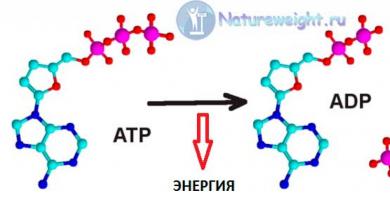Hello, dear readers and visitors! Well, sit back and get ready to listen carefully, because we have a very responsible topic ahead of us - anthropometry. To whom and for what, you ask? Of course, before you and future results. After all, the definition of initial, initial working data (to be worked on) very important task in any business. It's like the "given:" parameter, which is set initially, and we can't do anything with it.
So, I think you have already guessed that today we will talk about such issues as: all kinds of measurements, anthropometry, ideal body proportions in bodybuilding and other parameters that will serve us (you) as a kind of starting point in monitoring achievements (or vice versa) results workouts.
In general, we will determine all our initial physiological, metabolic, energy and other parameters of our body in order to have before our eyes a complete picture of all the changes that are happening to us. As a result, you will not only learn how to take all measurements correctly, but also learn about a new tool that will help you achieve your goal - a relief body, much faster.
Begin…
Anthropometry: ideal proportions in bodybuilding
To be honest, I don’t know many people who don’t want to lose a couple of kilograms or add a couple of centimeters to their bicep circumference. We all want to look attractive, and the topic of ideal proportions will always be very relevant, and doubly relevant for bodybuilders.
After all, the very concept of bodybuilding literally means “blind” your body, and not just like the song says: “I blinded it from what it was, and then ...”, but beautiful, athletic, symmetrical and correctly folded. Do you think why various bodybuilding tournaments have been held for more than a dozen years (like “ Mr. Olympia" or " Arnold classic”) . Everything is correct - this is not so much a competition of the type “who is bigger, that is cooler”, but rather who and how much managed to achieve those very ideal proportions and get closer to the harmoniously correct body symmetry.
You can at least three hundred times be the most massive in the gym, but a person will come who has much less muscles than you, but who has the correct body proportions, as you will clearly lose against his background. After all, bodybuilding is, first of all, the beauty of addition, and only then everything else. To make it clear what I'm talking about, I will give examples of athletes with symmetrical body proportions ( 1 ) and respected security officials ( 2 ), but with different proportions (see image).

If you descend from heaven to earth and plunge into the realities of most gyms, you can see a serious discrepancy in the structure of the body composition of many trainees (and obviously more than one year). For example, a massive upper part is several orders of magnitude ahead of the lower body or huge arms and a thin neck with a complete absence of shoulders. There are a lot of options here, take a closer look at those who are standing and working next to you, and you will see this kind of embarrassment.
Why am I talking about all this, but I just need to fill the article with something now I will explain. Many people think, they say, why do I need to know all this nonsense about the correct proportions of the body, because I'm not a performing bodybuilder and I have no one to show off. That's how it is, but proportions are also important in terms of determining those parameters and capabilities of your body, to which it can reach in the matter of the whole body. In addition to determining your genetic potential, you will also be more conscious in the process of training itself, knowing in advance which lagging parts of the body should be given special attention.
I will give a simple example. Very often, people approach their workouts in the gym "without a king in their head." Those. they have no idea at all about the necessary proportions of the body and they (let's say) with their hands like whips, they try to do incredible bicep curls on 40-50 kg, or on the shoulders with match legs. So, if you have an idea about the necessary proportions, then you can easily avoid such mistakes, so let's talk about the technical side (how, what and where should be) ideal proportions in bodybuilding.
Body anthropometry: it's all about the numbers
So, how attractive this or that person or this or that athlete is, does not depend on “taste”, but on “numbers”. Well, if we are dealing with numbers (as with a math operator), then the proportions must be described by some specific formula. And it is called - "golden section". This is a number that describes the entire body of a person. (e.g. length of arms and legs compared to torso) and determines which of its proportions are the most correct by nature and look the best. For example, the well-known drawing of the Vitruvian man Leonardo da Vinci (see image) to just a demonstration of the triumph of regular geometric shapes in the proportions of the human body.

In figures, the “golden section” looks like the ratio “ 1:1,618 ”, i.e. if your leg (thigh) is mistaken for 1 , then the leg and lower leg - should be 1,618 . In view of the fact that a person is a rational being, constantly striving for harmony, balance, symmetry, then we judge the beauty of the body by how the latter differs or does not differ from the ideally symmetrical body, which describes the "golden section". With regard to fitness / bodybuilding, you should understand that you need to take a comprehensive approach to your body and develop it harmoniously, paying attention to each. Here it is worth saying that by changing the most noticeable part - the ratio of the waist to the shoulders, you will immediately take a significant step towards a harmonious body.
Many bodybuilders try to optimize the waist-to-shoulder ratio as much as possible in the first place. 1:1,618 , also called the Adonis index (Oh, how people love all sorts of mythical words :-)).
Note:
If you are by body type (thin), then it will be easier for you to pump up your shoulders first, otherwise, first reduce your waist.
In order to achieve your ideal parameters, it is necessary, first of all, to determine the personal parameters of the "golden section", and then outline a specific action plan in the form of a correct training program. Now let's take a closer look at what parameters we have at the input, what to do with them and how to calculate our ideal proportions. Because people who come to the gym are all different in their structure and state of physical fitness, therefore, a universal parameter in determining the ideal proportions (what should be the volume of your muscles) the largest part of the body may protrude, and often it is the pelvis. Therefore, we will be repelled from it.
So, the ideal proportions of your body must satisfy the following ratios:
- the circumference of the pelvis and the circumference of the chest, should be 9:10 . Those. if your pelvis 90 cm (in circumference), then the circumference of the bust must match 100 cm;
- neck circumference should be 38% chest girth. If chest 100 cm, then the neck, respectively, 38 cm;
- forearm circumference should be 30% chest girth; If chest 100 cm, then the forearms should be 30 cm.
- waist circumference - 75% chest girth;
- hip circumference - 60% pelvic girth;
- calf circumference - the circumference of a tense biceps or 40% pelvic circumference, or 60% hip girth.
Also, your ideal proportions based on weight and height can be found in the following table (see table).

Note:
The weight/height ratio is the ratio of your weight (in kilograms) to your height (in centimeters). For example, your weight is 70 kg and height 180 cm means closest to your coefficient ( 0,388 ) meaning 0,39 , therefore, we look at the proportions corresponding to it.
Here, I dug up statistics on the anthropometry of famous athletes, I think it will seem curious to you (see table).

So, we smoothly approached the most interesting (I would even say, the creative process), namely - how to take measurements correctly, in order to then calculate the ideal proportions of the body?
Anthropometry: how to take measurements correctly
The most important thing is that you should adhere to certain rules, which sound like this:
- measurements are best done with an ordinary centimeter tape, but a budget option is also possible - a dense thread and a regular ruler;
- the most suitable time for measurements is in the morning, i.e. when the muscles are most relaxed and the body as a whole is “cold”.
Very often, many people say that their numbers are jumping, this just happens due to the fact that measurements are taken at different times of the day. Of course, after training, when the blood rushes to the muscles, your results may seem simply impressive, but after a while everything falls into place and the numbers are far from reality.
- the measuring tape should not sag or be too tight.
Do not embellish or try to influence the reliability of the data. A very common mistake - you want to seem better than you really are. And therefore, various tricks are used - retracting the abdomen when measuring the waist, taking air into the diaphragm when measuring chest girth, and so on. Of course, you want to reach the desired numbers by any means, not physically, but at least on paper, but be extremely objective about the accuracy of measurements and do not add / subtract extra centimeters.
- take measurements in the same places and several times ( 2-3 ) for a more accurate estimate.
It often happens that it is necessary to make a series of measurements in order to better verify the accuracy of the final result. In addition, if you are afraid that you will forget the place from which the measurement was made, then take a closer look at your body and remember (better write down) the characteristic "identifier" of this part of the body. For example, the zone is the forearm, the identifier is a mole on the inside of the arm at the desired measurement site. In general, highlight the characteristic details for each specific area being measured, so that it is easier to remember where to apply the meter next time.
- keep a diary of measurements and your personal photo archive-portfolio.
In the last one, enter the photos taken by the camera at the mirror from three angles (face, full face, profile) through each 2-3 month. So you can not only track your progress with the help of dry statistics, but also, most importantly, visually evaluate your result, which will allow you to move forward faster and faster.
Thus, based on all the collected data, you will be able to manage your training process and adjust the program on the go. Yes, at first this process will seem dreary, however, when you get involved and see the first results in the mirror, it will begin to motivate you in a non-illusory way to move forward towards your goal. Now a few words about how, what and where to measure. For a visual demonstration, I will give the following illustration. (see image).

Main measurement locations (see table) .

The rest of the measurement points look like this.

Note:
From the point of view of correct / shaped proportions - the volume of the biceps, neck and calves should be the same, then they say that the person is athletically well built.
Actually, we have finished with anthropometry, but there are a number of indicators that also need to be kept in mind when monitoring achievements. Now we will consider them.
Anthropometry: body mass index, pulse and energy expenditure
BMI

The simplest and at the same time the most “speaking” indicator is the weight of your own body. We all know how to measure it and how it should ideally be. So, the weight or mass of a body is a certain measure of all that amount of matter and substance (fluids, fats, muscle and bone mass) that is contained in a person. The most popular formula that everyone hears about for determining the required body weight is:
optimal body weight \u003d height (cm) - 100 (u)
In addition, there is such a thing as the concept of the Body Mass Index or body mass index, which allows you to assess the degree of correspondence between a person’s height and his mass in order to identify possible deviations in the latter.
Calculation formula:
Body mass index (BMI) \u003d M / H 2,
where: M - human body weight (in kilograms);
H is the person's height (in meters).
The optimal BMI for men is considered to be an index in the range 25-27 units, however, for the fair sex, this is the so-called pre-obesity threshold.
Note:
Tables for estimating the value of BMI are not difficult to find on the Internet. (as they say, Google help you).
Because the correct proportions and symmetry of all muscle groups are important to us, therefore, this indicator is not suitable for us to assess the optimal body weight, because the physique of bodybuilders is different from the average person, and the high BMI value can only be explained by more developed muscles. Those. BMI does not measure body composition.
Note:
To make this BMI calculation more accurate, the waist-to-hip ratio must be taken into account. To do this, measure the volumes of the latter, then dividing the first value by the second. In men, the resulting ratio should normally be 1 , and for women 0,85 . If the waist circumference goes beyond the specified values, then it makes sense to think about removing the tummy.
I would like to say that the most famous and affordable way for a person to measure body weight is floor scales, however, athletes (especially bodybuilders) and everything is not so simple here, because it is necessary to clearly monitor the proportions of the body, in particular, for such parameters as: levels of fat, water and muscle / bone mass. This can be done thanks to special electronic scales with body composition analyzers. In general, a bodybuilder's body composition is best measured in terms of lean and fat mass.
Lean mass is the sum of the weight of bones, muscles, internal organs and fluid, everything else is adipose tissue. Needless to say, for different sports, the optimal values of lean and fat mass are different. On average, the percentage of adipose tissue is in the range from 7 before 15% and it can be assessed using a special method - bioimpedancemetry, however, for this it is worth visiting a sports medicine clinic.
If funds or a proper institution are not at hand, then a budget option is quite suitable, a caliper is an individual skinfold thickness gauge from a simple pharmacy. Total fat folds in the human body 6 :
- shoulder;
- chest;
- subscapular;
- abdominal;
- iliac;
- femoral.
We measure everything 6 fat folds (how to do it right, I will tell in a separate article), add up their values and apply the formula:
Fat Percentage Formula
- Age (less 30 years):
(Sum of folds, mm) x 0.097 + 3.64
- Age (over 30 years):
(Sum of folds, mm) x 0.1066 + 4.975
Pulse rate

It would seem that an unimportant indicator, however, the effectiveness of the training largely depends on the heart rate during classes. For example, when gaining muscle mass and strength training, a high heart rate has a negative effect on the heart and triggers catabolic processes (destruction) in the muscles earlier. Low heart rate (when using a stationary bike or treadmill) when losing weight - not the most effective way to burn fat, even regardless of the time spent. Therefore, it is important to know and work in your target heart rate zone for a specific physical activity.
So, to assess the intensity of training, the Karvonen formula is used :
Training heart rate (HR) = (maximum heart rate - resting heart rate) x intensity (%) + resting heart rate.
For example, you 20 years and heart rate at rest is 60 . You want to know at what heart rate you need to train so that the intensity of the load is 80% ?
The calculations are as follows:
- 220 – 20 = 200 (maximum heart rate);
- 200 – 60 = 140;
- 140 x 80% = 112;
- 112+60 = 172.
It turns out that the heart rate during training with intensity 80% from the maximum, will be approximately 172 beats per minute. You can change the formula and calculate the intensity:
Intensity (%) = (HR during training - HR at rest) / (maximum HR - HR at rest);
It is worth noting here that you can gradually increase the intensity of aerobic exercise, starting from 50% and moving gradually to the target area of work in 70-80% (with time duration 40 minutes), if your goal is to lose weight overboard.
Thus, summing up all of the above, we can say that by changing the intensity of training (including by reducing or increasing) and rest time, you can adjust your heart rate to stay in your target heart rate zone, which will allow you to achieve the maximum result in each workout.
Everybody is here. And the last one for today.
Energy costs
The most common mistake in weight loss (or just a stop in the results of training) This is a miscalculation of calories. We talked about energy costs in general in the article “”, now it's time to talk about how to calculate them.
BX
So, the following numbers are used to estimate the basal metabolic rate (OB).
- Men: 1 x M, kcal/hour, where M is body weight (kg)
- Women: 0.9 x M, kcal/hour, where M is body weight (kg)
For example, the value of OB in an average man, weighing 70 kg, is 1680 kcal.
To calculate OB, there is the Harris-Benedict formula.
- Men (over 10 years old): 66.47 + 13.75 x M + 5 x P - 6.74 x G, where M - body weight (kg), R - height (cm) G - age (years);
- Women (any age): 655.1 + 9.6 x M + 1.85 x P - 4.68 x G, where M - body weight (kg), R - height (cm) G - age (years);
Energy expenditure of physical activity
During the day, a person is engaged in various activities: either he will take out the garbage, then he will wash the laundry, then he will go shopping, or maybe he will soap himself in the gym :). So, for all this activity, he spends a different amount of energy, therefore, for some general assessment of the types of human activities, there is a special coefficient of physical activity (CFA). It shows how many times a person spends more energy per unit of time than when spending if he did nothing at all (i.e. more than the basal metabolic rate).
If we analyze it in specific numbers, then a medium-intensive workout in the gym equates to a CFA equal to 7 . This means that the person 1 spend an hour in 7 times more energy than if he "didn't turn over". Again, let's look at the numbers. Athlete weighing 80 kg, for 1 hour of work in the hall will spend 560 kcal.
Thus, knowing the value of the basal metabolism, we can calculate the number of kilocalories that an athlete spends on training in the gym. From this it follows that we can calculate the amount of energy that the student spends during the day. Then we can calculate the number of calories that we eat with food.
In summary, if our goal is weight loss, then the calorie balance should be negative, i.e. must have a negative caloric balance (consumed less than what we spend). If the goal is the opposite, then you need to consume more calories than you spend.
There is a KFO table for various activities. According to its data, you can calculate: your basal metabolism, the number of calories that you spend during the day (based on your type of activity) and how many calories you spend in the gym.
Note:
The CFA table for various types of activities is freely available, so you can easily find it.
Summarizing a little all of the above, it should be noted that the most complete idea of the correct balance of energy gives us body weight. It is her constancy that speaks of the correspondence between the consumed and consumed energy. However, if we need (and we need) to improve the shape of the body (its structure), then we need to deal with the increase in lean mass and decrease in fat, which means that training in the gym and proper nutrition will help us!
She figured it out, well, it seems that they didn’t miss anything, it remains only to draw conclusions.
Afterword
We did a good job today (and I'm straight ahead) and learned a lot not only about the ideal proportions of the body in bodybuilding, learned what anthropometry is and learned something about the control of results. I am sure that the article will be useful to you, and you will learn a lot of new things for yourself. That's it, one more step towards the goal has been made. I am glad that we were with the project “ ”!
See you again.
PS. If you have questions about body measurements or something is not clear in general, comments will help you, write!



